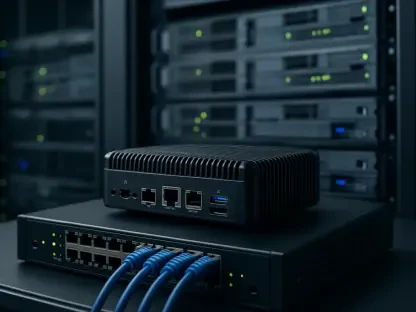In a move that has sent ripples through the tech industry, the U.S. government is reportedly contemplating a ban on TP-Link routers, a brand that dominates the consumer and small business market with an estimated share of up to 50%. This potential prohibition isn’t just a regulatory footnote; it’s a flashpoint in the escalating tension between national security and global technology supply chains. Millions of American households and businesses rely on TP-Link for affordable, reliable internet connectivity, making the stakes incredibly high. The core of this proposed action lies in fears over cybersecurity vulnerabilities and alleged connections to foreign influence, particularly from China. As cyberattacks grow more sophisticated, the scrutiny of foreign-made tech intensifies, positioning this ban as a critical case study in balancing safety with accessibility. This discussion will explore the reasons behind the government’s stance, the company’s defense, and the broader implications for consumers and the industry at large.
Unpacking National Security Concerns
The primary impetus for the proposed ban stems from deep-seated apprehensions within the U.S. government about TP-Link’s ties to China and the potential risks these connections pose to national security. Federal agencies, including the Department of Commerce, have expressed alarm over how these routers handle sensitive American data, viewing them as possible conduits for foreign interference. Reports have surfaced detailing how Chinese state-sponsored hacking groups have exploited TP-Link devices in cyberattacks, using tactics like malicious firmware implants to compromise systems. The presence of these routers on U.S. military bases has further intensified concerns, as any vulnerability in such critical environments could have dire consequences. This situation underscores a broader narrative of distrust toward technology linked to certain foreign entities, prompting officials to consider drastic measures to safeguard digital infrastructure against espionage and data breaches that could undermine national interests.
Beyond the immediate fears of data breaches, the national security debate also hinges on the broader geopolitical climate between the U.S. and China. Documented incidents of cyber exploitation, such as password-spraying attacks targeting American accounts, have been traced back to vulnerabilities in TP-Link hardware, adding weight to the government’s position. Congressional committees have pointed to specific laws in China that could compel companies to cooperate with state directives, raising questions about whether TP-Link could be pressured to act against U.S. interests. While the evidence of specific threats tied to this brand is compelling, it also opens up a larger conversation about how much risk is inherent in relying on globally sourced technology. The government’s focus on TP-Link appears to be as much about setting a precedent as it is about addressing a singular threat, signaling a tougher stance on foreign tech in sensitive sectors and pushing for stricter oversight across the board.
TP-Link’s Defense Against the Allegations
In response to the mounting accusations, TP-Link has mounted a robust defense, firmly denying any undue influence from the Chinese government. The company emphasizes its operational independence, highlighting a structural separation from its China-based parent entity over recent years as evidence of its autonomy. With a U.S. headquarters in California and additional bases in Singapore and Vietnam, TP-Link argues that its global presence mitigates concerns about centralized control from any single nation. Furthermore, it refutes claims of inflated market dominance, suggesting its share is closer to 30% rather than the widely cited 50%, and insists that its products meet high standards of security and quality for American consumers. This pushback aims to reassure both the public and policymakers that the brand poses no unique threat, positioning itself as a reliable player in a competitive market rather than a security liability.
Adding to its argument, TP-Link points to its in-house control over critical aspects of production, from research and design to manufacturing, with the exception of certain chipsets sourced externally. A spokesperson has publicly reiterated the company’s commitment to delivering secure networking solutions, challenging the narrative that its devices are inherently vulnerable due to their origins. This stance raises important questions about whether the scrutiny on TP-Link is disproportionately harsh compared to other firms with similar global supply chains. By framing itself as a transparent and independent entity, the company seeks to shift the conversation toward factual assessments of its practices rather than assumptions driven by geopolitical bias. This defense not only addresses the immediate threat of a ban but also attempts to preserve consumer trust in a market where affordability and performance have made TP-Link a household name for many.
Industry-Wide Cybersecurity Vulnerabilities
While TP-Link is under the spotlight, it’s crucial to recognize that cybersecurity challenges are not exclusive to this brand. Many competitors in the networking hardware space, including well-known names like Cisco and Netgear, also rely on components sourced from China and have faced comparable threats from hackers across the globe. Consumer-grade routers, regardless of manufacturer, often ship with insecure default settings or outdated firmware, rendering them easy targets for botnets and other malicious actors. This pervasive issue suggests that targeting a single company might not address the root causes of digital insecurity. Instead, it highlights a systemic problem within the industry, where cost-cutting measures and lack of stringent security standards leave millions of users exposed to risks that transcend brand loyalty or country of origin.
Delving deeper, the industry’s struggle with cybersecurity reveals a gap between technological advancement and user safety. Advanced persistent threat groups from various nations have exploited these widespread vulnerabilities, not just in TP-Link products but across the board, turning everyday devices into tools for large-scale cyberattacks. The question then becomes whether a ban on one manufacturer can meaningfully enhance security when the underlying issues—such as inadequate default protections and delayed firmware updates—remain unaddressed by most players. This broader perspective suggests that a more comprehensive approach, involving industry-wide regulations and mandatory security protocols, might be necessary to tackle the epidemic of router vulnerabilities. Without such measures, consumers could face the same risks regardless of which brand replaces TP-Link in the market, underscoring the need for systemic reform over isolated punitive actions.
Economic Ramifications for Consumers and Providers
The potential ban on TP-Link routers carries significant economic implications, particularly given the brand’s reputation for affordability. For countless households and small businesses, as well as Internet Service Providers (ISPs) that often bundle TP-Link devices with their plans, these routers represent a cost-effective solution for reliable internet access. Removing this option from the market could lead to a noticeable increase in costs as consumers and providers turn to more expensive alternatives that may not necessarily offer superior security features. This shift risks creating a financial burden, especially for those on tight budgets who have come to depend on TP-Link’s competitively priced hardware to stay connected in an increasingly digital world, raising concerns about accessibility and equity in technology adoption.
Moreover, the economic ripple effects extend beyond individual users to the broader market dynamics between manufacturers and service providers. ISPs, which frequently distribute TP-Link routers due to their performance and low cost, might face logistical challenges and higher expenses in sourcing replacements, potentially passing these costs onto subscribers. If alternative brands carry similar cybersecurity risks, as industry trends suggest, the trade-off between price and protection becomes murky. This scenario highlights a critical tension: while the intent behind the ban may be to enhance security, the immediate outcome could be a market disruption that disadvantages budget-conscious consumers without delivering a proportionate safety benefit. Policymakers must weigh these economic consequences against the urgency of national security, ensuring that any action taken does not inadvertently penalize those least equipped to absorb the cost.
Consumer Dilemmas and Practical Impacts
For the average user, news of a potential ban on TP-Link routers can be both confusing and concerning, prompting difficult decisions about whether to continue using current devices or invest in alternatives. Many may hesitate to switch, given that replacement options often come with a higher price tag but not always with guaranteed improvements in security. The reality is that a significant number of consumers remain unaware of the inherent vulnerabilities in their networking equipment, such as default usernames and passwords that go unchanged for years. This lack of awareness places an unfair burden on individuals to safeguard their digital environments, especially when manufacturers have historically prioritized ease of use over robust protection, leaving users exposed from the moment they plug in their devices.
Adding to the complexity, the proposed ban shines a light on the disparity between consumer expectations and the technical demands of maintaining a secure network. Even if users opt for a different brand, the pervasive issue of insecure configurations across the industry means that the risk may not diminish significantly. This situation underscores the urgent need for better education around basic cybersecurity practices, such as regularly updating firmware and changing default settings. Until such knowledge becomes commonplace, or manufacturers take greater responsibility for out-of-the-box safety, consumers are left navigating a landscape where a ban might alter their choices but not necessarily their level of protection. The uncertainty surrounding this policy move thus serves as a wake-up call for individuals to take proactive steps, even as broader solutions remain elusive.
Emerging Solutions for Router Security
Amid the uncertainty surrounding the proposed ban, there are signs of progress within the industry that could help mitigate some of the security concerns tied to routers. Certain manufacturers are beginning to integrate user-friendly safeguards into newer models, such as mandatory password changes during setup and automatic firmware updates to patch vulnerabilities. Brands like Amazon’s Eero and Netgear’s Orbi are leading the way in this regard, aiming to reduce the burden on users to manage complex security settings. While these advancements are not yet universal, they signal a shift toward prioritizing consumer safety over mere convenience, offering a potential blueprint for how the industry can evolve to address long-standing weaknesses in networking hardware without relying solely on regulatory interventions like bans.
For those with technical expertise, alternative solutions such as open-source firmware provide another avenue to enhance router security. Options like OpenWrt and DD-WRT, compatible with many TP-Link models and other brands, allow users to customize their devices with enhanced features and protections against known vulnerabilities. However, these solutions require a level of skill and commitment to manual updates that may deter the average consumer. Additionally, upgrading outdated hardware—particularly devices older than five years—can improve both performance and security, especially for households heavily reliant on WiFi. These steps, while not a complete fix, represent practical measures that users can adopt to bolster their defenses, suggesting that individual action, paired with industry innovation, could play a critical role in navigating the challenges posed by the current security landscape.
Navigating Geopolitical Tech Tensions
Zooming out from the specifics of TP-Link, the proposed ban reflects a larger undercurrent of geopolitical friction between the U.S. and China in the realm of technology. National security concerns frequently intersect with economic and political priorities, casting a shadow of suspicion over Chinese-linked tech, especially in sensitive contexts like military installations. Evidence of cyberattacks exploiting TP-Link devices lends credence to the government’s cautious approach, yet it also prompts scrutiny of whether targeting a single company adequately addresses the multifaceted nature of cyber threats. This tension illustrates how technology has become a battleground for broader strategic rivalries, where decisions about hardware bans are as much about signaling political resolve as they are about tangible security gains.
Furthermore, the focus on Chinese technology risks oversimplifying a complex global supply chain where many nations, including allies, contribute to the components and software in consumer devices. The industry’s shared vulnerabilities suggest that a narrow emphasis on one brand or country of origin might miss the forest for the trees, failing to tackle the universal challenges of cybersecurity that transcend borders. As the U.S. grapples with these geopolitical dynamics, the TP-Link case serves as a microcosm of the difficulties in securing digital infrastructure while maintaining an open, competitive market. This broader context indicates that while immediate actions like bans may address specific risks, long-term stability will likely require international cooperation and standardized security protocols to fortify the tech ecosystem against evolving threats.
Reflecting on a Path Forward
Looking back, the debate over the proposed ban on TP-Link routers crystallized the intricate balance between safeguarding national interests and preserving consumer access to affordable technology. It brought to light genuine concerns about cybersecurity and foreign influence, as evidenced by documented exploits of TP-Link devices in malicious attacks. At the same time, it exposed the limitations of targeting a single entity when vulnerabilities permeated the entire industry. The discussions that unfolded revealed a shared responsibility among governments, manufacturers, and users to address these challenges holistically.
Moving ahead, the path forward demands a multifaceted approach. Policymakers are urged to consider comprehensive cybersecurity standards that apply uniformly to all networking equipment, ensuring that security enhancements do not come at the expense of market accessibility. Manufacturers need to accelerate the adoption of built-in protections, while consumers are encouraged to stay informed about basic security practices. This pivotal moment in tech policy serves as a reminder that protecting digital infrastructure requires collaboration across all stakeholders, paving the way for more resilient solutions in an interconnected era.









